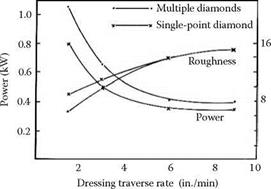The control wheel is usually a rubber bond wheel. The rubber bond allows the regulating wheel to fulfill three important functions. These are to provide sufficient friction for speed control, to provide sufficient flexibility for error averaging, and to provide a surface that can be easily machined to provide accurate positioning. The rubber bond satisfies each of these requirements.
 |
For multidiameter work, the control wheel must be stepped. The step height on the regulating wheel must match the step height on the workpieces to ensure support for the workpiece along an adequate proportion of the length. Normally, support will be provided along the entire length of the workpiece.
Angular adjustment of the control wheelhead may be provided in the horizontal plane. This adjustment is convenient for achieving parallel setup and elimination of small workpiece taper errors.
Angular adjustments should also be provided in the vertical plane for provision of an axial feed force. This introduces a further requirement for dressing feed angular adjustments to achieve the necessary control wheel profile as discussed in the next section.
